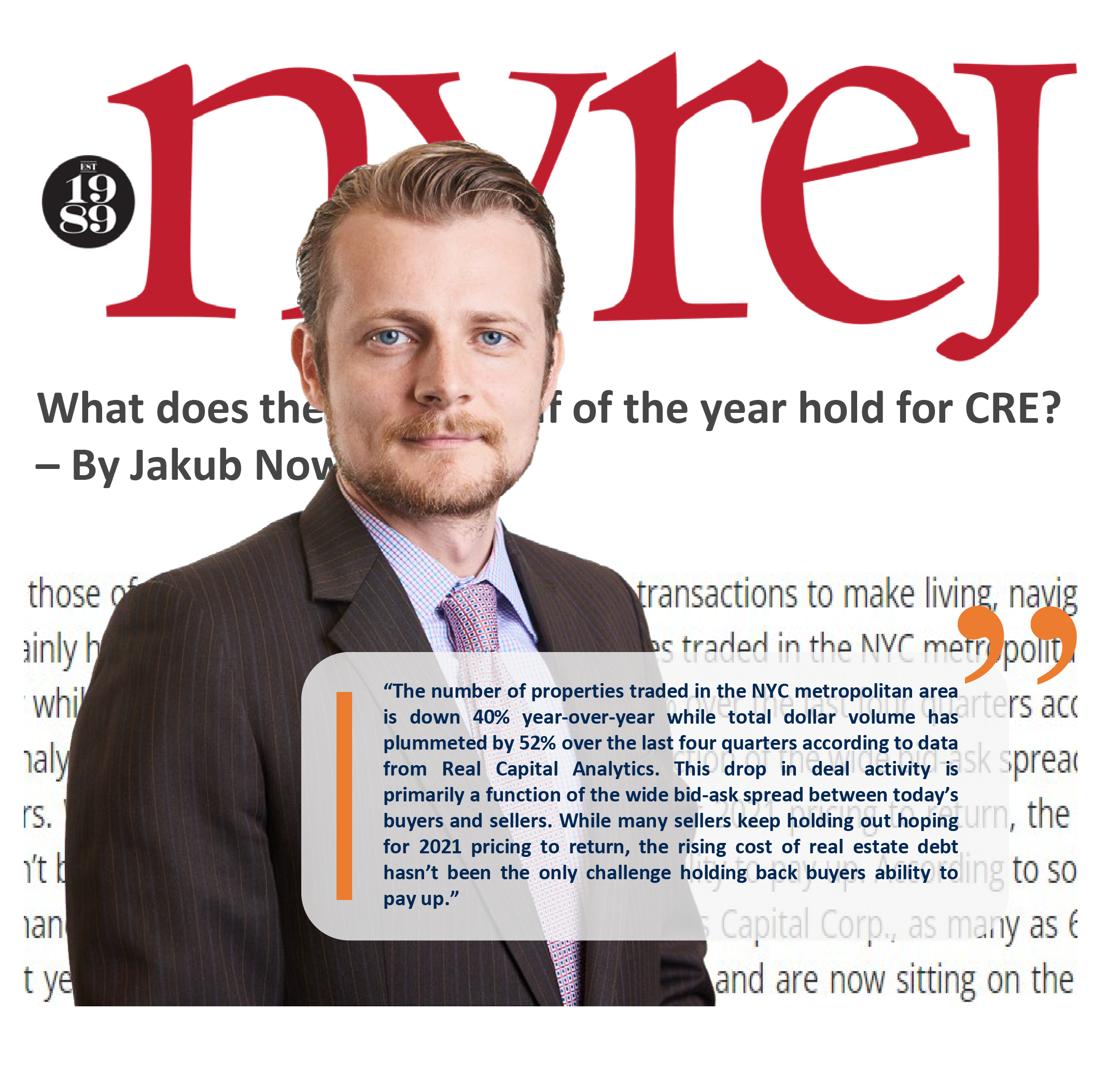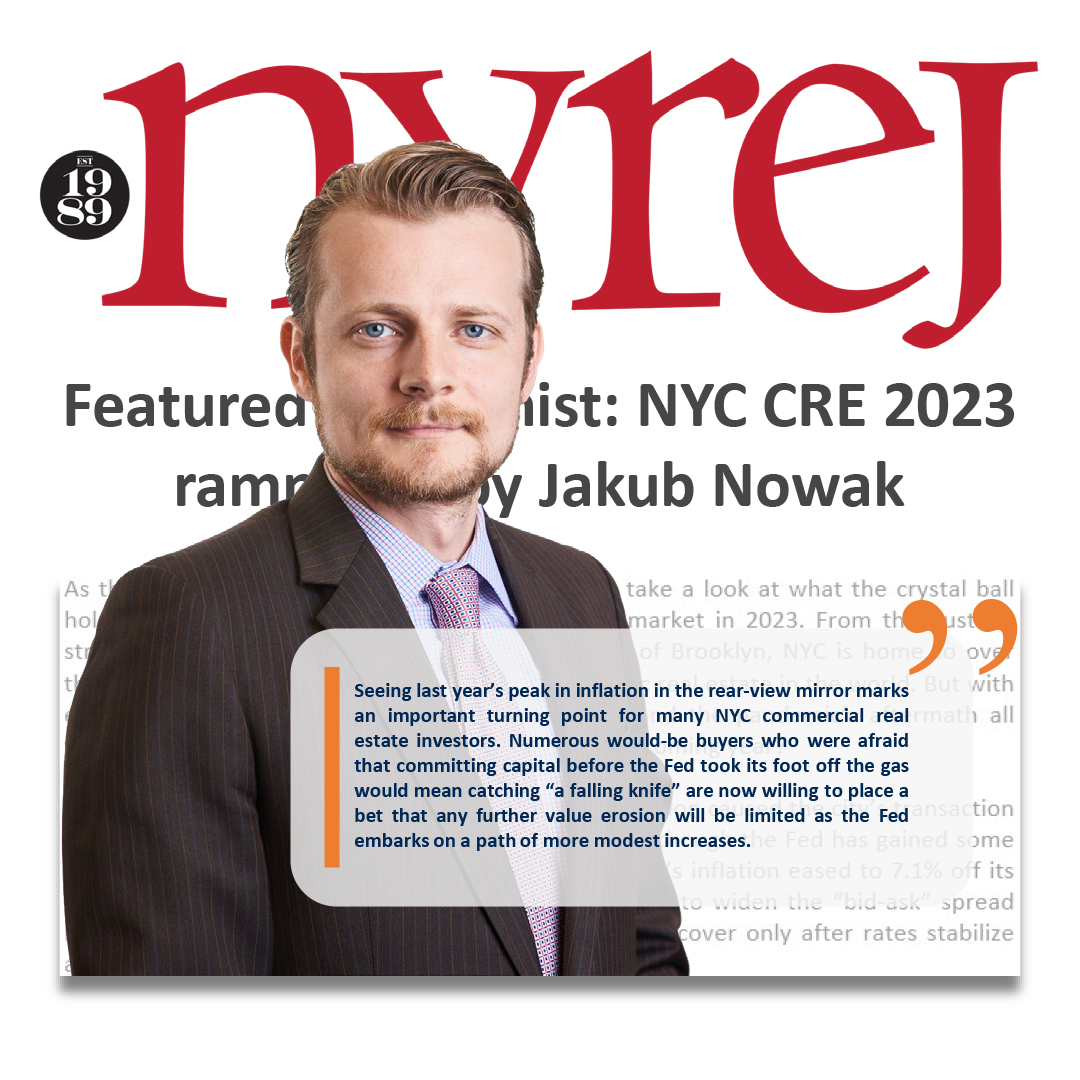
NYC CRE 2023 ramp up – by Jakub Nowak
Articles Blog Post
January 26, 2023
As the curtain closes on another year, it’s time to take a look at what the crystal ball holds for New York City’s commercial real estate market in 2023. From the bustling streets of Manhattan to the trendy neighborhoods of Brooklyn, NYC is home to over three trillion dollars’ worth of some of the most iconic real estate in the world. But with economic uncertainty, ongoing interest rate hikes and the pandemic’s aftermath all vying for attention, what can investors expect for the coming year?
Aggressive rate hikes made in response to surging inflation caused the city’s transaction volume to plummet by 30% from Q2 to Q3 in 2022. Although the Fed has gained some flexibility to limit future rate increases after December’s inflation eased to 7.1% off its summer high of 9.1%, ongoing rate hikes will continue to widen the “bid-ask” spread between buyers and sellers. Transaction volume will recover only after rates stabilize and the market reaches a new price equilibrium. At that time, demand from capital waiting on the sidelines will begin to absorb inventory from sellers willing to sell at the new price level. Until that occurs, most of the transactions will be driven by investors with maturing debt that can no longer be refinanced without an equity injection. Investors who lack the equity themselves and are unable to raise enough funds to meet this capital need will be forced to sell. The longer rates stay on their upward trajectory, and the more of these financing-driven sales materialize, the stronger the downward pressure on prices will be until the market stabilizes.
Inflation and rising interest rates will impact different property types to varying degrees. Properties with the ability to pass on rising costs to tenants and raise net operating income will perform better than those with limited opportunities to add value. Markets with strong rent fundamentals and shorter lease terms or strong rent escalations will remain in demand as a draw to capital looking for safe havens and a hedge against inflation. In contrast, properties in tertiary markets or with long lease durations and low rent increases will experience ongoing value erosion until the market takes a turn for the better.
This will be most evident in the NYC multifamily sector, as the value gap between rent-controlled and free-market properties widens. Free-market properties will benefit from rent growth driven by the influx of people after the pandemic and the inability of many to afford home ownership due to high interest rates. Rent-stabilized properties, on the other hand, will face shrinking operating margins as higher rates and inflation drive up expenses and rent growth fails to keep pace. This is especially true after 2019’s rent reform law eliminated any meaningful way to increase rents in vacant rent stabilized units. All that being said, should NY pass some form of “good-cause eviction”, then all bets are off, and this distinction might no longer hold.
Although the Fed’s actions have dominated headlines, the most fundamental driver for the City’s economy and its real estate market is its population. According to new data, New York City’s population grew by 2.14% (189,000 people) since 2020. This remarkable recovery from the diaspora of the early pandemic is a reminder that “you should never bet against New York”. The City’s urban core remains the epicenter around which people want to live their lives, especially young professionals and recent graduates who come in droves to live, work and play in our vibrant metropolis. A recovery in the office and retail sectors relies on this trend to continue and on people to gradually come back to work in the office, even as companies experiment with varying degrees of hybrid work models. The good news is that while many want to continue working from home some of the time, few are willing to give up the benefits of having an office.
The threat to this recovery comes from a combination of a worsening affordable housing crisis, an overall rise in the cost of living and concerns for personal safety from soaring crime. High earners in particular, many of whom are a driving force behind the City’s businesses and tax revenues, have been leaving the City due to rising crime, dirtier streets, and its high tax burden. Meanwhile the housing crisis has been compounding since 2019’s rent reform law drove owners to ‘warehouse’ over 40,000 stabilized apartments instead of re-renting them at a loss, contributing to soaring rents by taking these units out of circulation. Further, last year’s expiration of the “Affordable New York” Tax Abatement has made it nearly impossible to construct new affordable rental housing, removing any meaningful relief that might have come from adding more units to the supply-side.
The City’s recovery in large part hinges on the state legislature’s ability to address these issues. Alleviating the affordable housing crisis, implementing policies targeting the recent crime surge, encouraging more international tourism, addressing our ever-increasing tax burdens and attracting the talent of tomorrow are all part of the fuel needed for NYC to bounce back stronger than ever. Strong leadership is needed to bring about a new housing program allowing us to get back to pre-pandemic levels of housing development and to revise the significant shortcomings of 2019’s rent reform law. We should all pay close attention to what action is taken in Albany as the legislation reconvenes this January.
Jakub Nowak is a senior managing director investments and team lead at the Nowak Group of Marcus & Millichap Brooklyn, N.Y.




